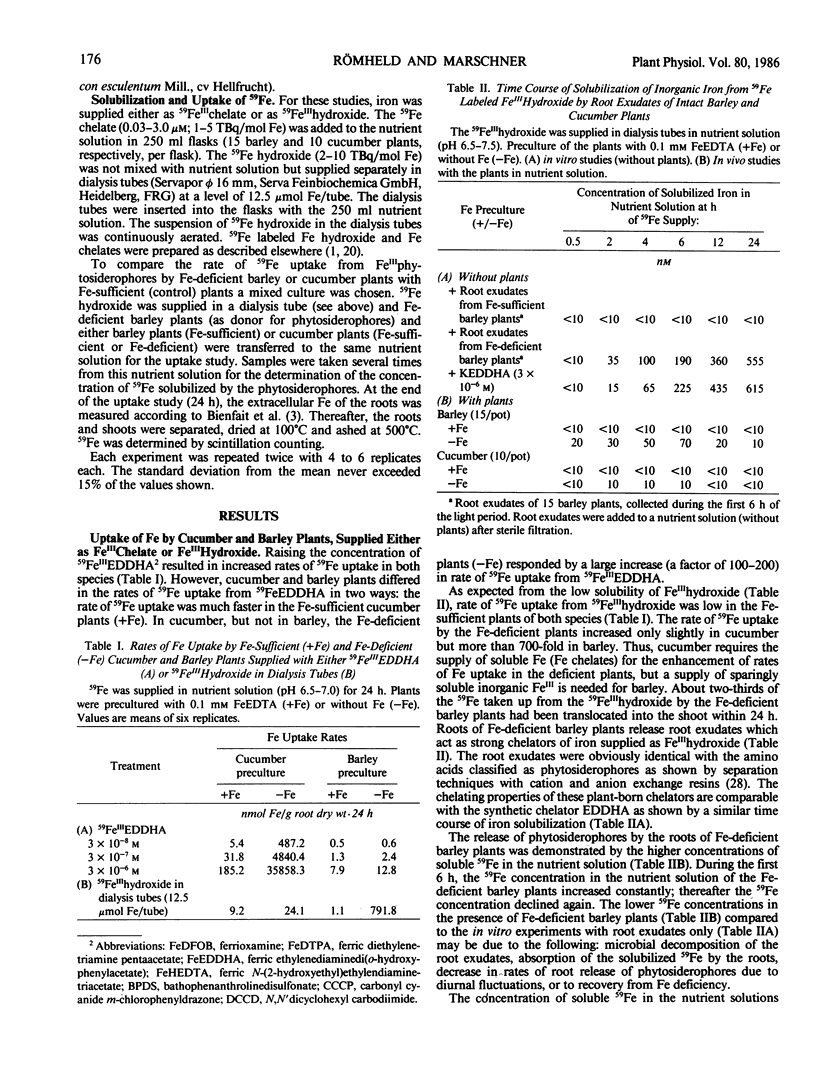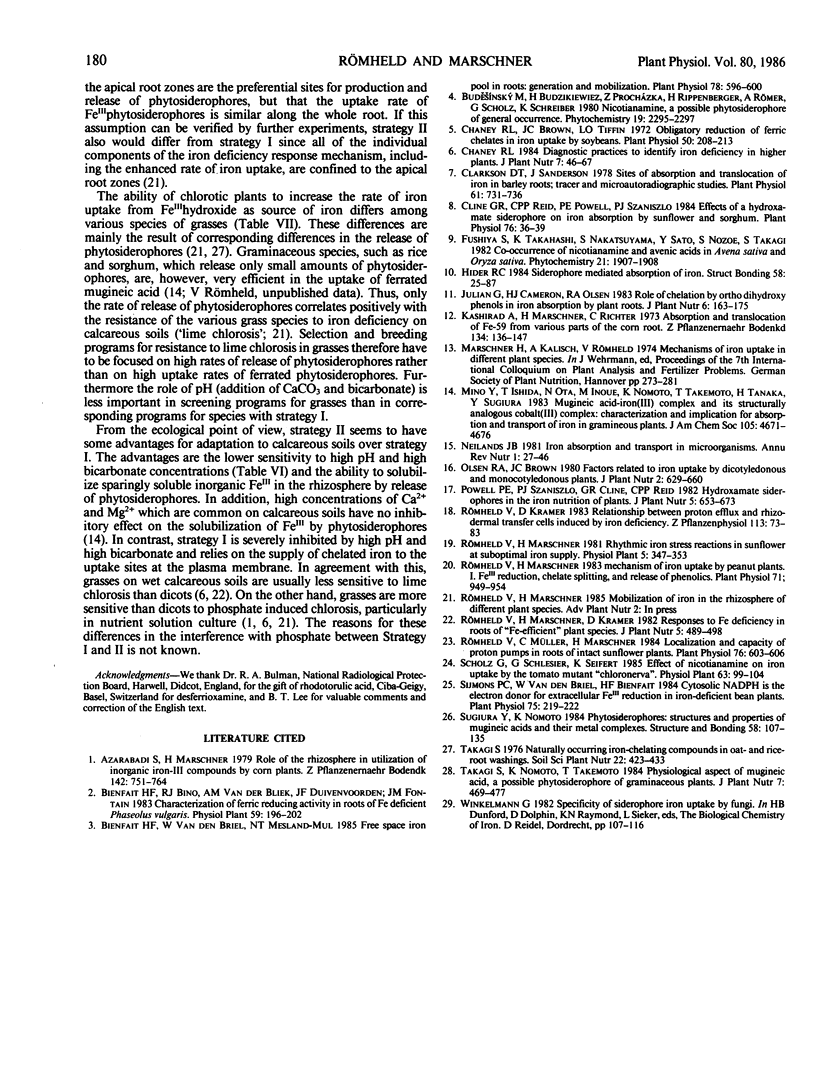Abstract
Roots of grasses in response to iron deficiency markedly increase the release of chelating substances (`phytosiderophores') which are highly effective in solubilization of sparingly soluble inorganic FeIII compounds by formation of FeIIIphytosiderophores. In barley (Hordeum vulgare L.), the rate of iron uptake from FeIIIphytosiderophores is 100 to 1000 times faster than the rate from synthetic Fe chelates (e.g. Fe ethylenediaminetetraacetate) or microbial Fe siderophores (e.g. ferrichrome). Reduction of FeIII is not involved in the preferential iron uptake from FeIIIphytosiderophores by barley. This is indicated by experiments with varied pH, addition of bicarbonate or of a strong chelator for FeII (e.g. batho-phenanthrolinedisulfonate). The results indicate the existence of a specific uptake system for FeIIIphytosiderophores in roots of barley and all other graminaceous species. In contrast to grasses, cucumber plants (Cucumis sativus L.) take up iron from FeIIIphytosiderophores at rates similar to those from synthetic Fe chelates. Furthermore, under Fe deficiency in cucumber, increased rates of uptake of FeIIIphytosiderophores are based on the same mechanism as for synthetic Fe chelates, namely enhanced FeIII reduction and chelate splitting. Two strategies are evident from the experiments for the acquisition of iron by plants under iron deficiency. Strategy I (in most nongraminaceous species) is characterized by an inducible plasma membrane-bound reductase and enhancement of H+ release. Strategy II (in grasses) is characterized by enhanced release of phytosiderophores and by a highly specific uptake system for FeIIIphytosiderophores. Strategy II seems to have several ecological advantages over Strategy I such as solubilization of sparingly soluble inorganic FeIII compounds in the rhizosphere, and less inhibition by high pH. The principal differences in the two strategies have to be taken into account in screening methods for resistance to `lime chlorosis'.
Full text
PDF





Selected References
These references are in PubMed. This may not be the complete list of references from this article.
- Bienfait H. F., van den Briel W., Mesland-Mul N. T. Free space iron pools in roots: generation and mobilization. Plant Physiol. 1985 Jul;78(3):596–600. doi: 10.1104/pp.78.3.596. [DOI] [PMC free article] [PubMed] [Google Scholar]
- Chaney R. L., Brown J. C., Tiffin L. O. Obligatory reduction of ferric chelates in iron uptake by soybeans. Plant Physiol. 1972 Aug;50(2):208–213. doi: 10.1104/pp.50.2.208. [DOI] [PMC free article] [PubMed] [Google Scholar]
- Clarkson D. T., Sanderson J. Sites of absorption and translocation of iron in barley roots: tracer and microautoradiographic studies. Plant Physiol. 1978 May;61(5):731–736. doi: 10.1104/pp.61.5.731. [DOI] [PMC free article] [PubMed] [Google Scholar]
- Cline G. R., Reid C. P., Powell P. E., Szaniszlo P. J. Effects of a hydroxamate siderophore on iron absorption by sunflower and sorghum. Plant Physiol. 1984 Sep;76(1):36–39. doi: 10.1104/pp.76.1.36. [DOI] [PMC free article] [PubMed] [Google Scholar]
- Neilands J. B. Iron absorption and transport in microorganisms. Annu Rev Nutr. 1981;1:27–46. doi: 10.1146/annurev.nu.01.070181.000331. [DOI] [PubMed] [Google Scholar]
- Römheld V., Marschner H. Mechanism of iron uptake by peanut plants : I. Fe reduction, chelate splitting, and release of phenolics. Plant Physiol. 1983 Apr;71(4):949–954. doi: 10.1104/pp.71.4.949. [DOI] [PMC free article] [PubMed] [Google Scholar]
- Römheld V., Müller C., Marschner H. Localization and capacity of proton pumps in roots of intact sunflower plants. Plant Physiol. 1984 Nov;76(3):603–606. doi: 10.1104/pp.76.3.603. [DOI] [PMC free article] [PubMed] [Google Scholar]
- Sijmons P. C., van den Briel W., Bienfait H. F. Cytosolic NADPH is the electron donor for extracellular fe reduction in iron-deficient bean roots. Plant Physiol. 1984 May;75(1):219–221. doi: 10.1104/pp.75.1.219. [DOI] [PMC free article] [PubMed] [Google Scholar]


